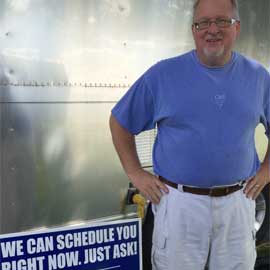
ADVICE FOR THE NEW RV OWNER
RV HOLDING TANKS 101: WHAT NEWBIES NEED TO KNOW
2020 was an unprecedented year for us for many reasons. One stood out above others: We cleaned the holding tanks of more first-time RVers than any year in our history of doing business. That’s not surprising, considering the RV industry saw an explosive growth in new RV sales in 2020. RV dealerships were even scrambling to meet demand by tempting current RV owners to trade-in or sell their used RVs outright. What many new owners were left with were problems from previous owners.
There was one common theme we saw with every first time RVer we serviced: A severe lack of knowledge when it came to how their RV’s systems worked. We spent more time going over the basics of RVing than ever before, even going beyond our “area of expertise.”
Here’s some of the things every new RVer should know about their RV’s waste handling systems:
This is not like your house
While it may seem pretty straightforward, we found a lot of new owners thinking of their RV’s tanks and waste system as they would their home: Just “do your business,” flush, and forget.
The truth is, no matter what make or model of RV you have, there’s a level of “primitiveness” to the waste disposal situation. Yes, the toilet (and shower and sinks) in your RV look pretty much like the ones in your house. Yes, everything tends to go down pipes and out of your thoughts. And yes, there’s a process — maybe a bit more hands-on with an RV — to getting rid of what is not wanted.
RV’s holding tanks are just that: tanks that hold waste. They are not composting or septic systems. Things don’t break down in there (very much). They are merely meant to temporarily hold the waste you don’t want until you are ready to get rid of it and send it on its way.
Stop dumping stuff in your tanks
As an RV newbie, you need to realize that your waste holding tanks are only temporary stopping points (as in a few hours or days). We’re told by RV dealers, other owners, and countless “RV experts” online that we need to dump additives into our holding tanks.
That’s wrong.
With seven years of experience servicing RVs of all types, we am here to tell you to stop putting enzymes, biologicals, and harsh chemicals down your tanks. These only break down waste into a sludgy, pancake-like batter. It’s sticky, smelly, and hard to get out of your tanks. It’s those tank additives that are causing your tank sensors to stop working. Go figure!
More water is the key
New RVers (and even a lot of long-timers) ask us what is the one thing they can do to make their holding tanks perform better. It’s simple, really. Use more water!
The pipes in your RV are often smaller than those in your house. The amount of water contained in one RV toilet tank flush is far less than in a household toilet. And those holding tanks are something your house doesn’t have and they’re a lot closer to the living space than we’d like. Using more water when you use the toilet (especially), can help everything work better.
We always say, fill the toilet bowl half way (or so) with water, do your business and flush, fill it up almost full again and flush it, then fill the bowl halfway with water again, to act a seal and to get your toilet ready for the next use.
Using plenty of water also tends to keep things lubricated in the holding tanks and dilutes the contents of the tanks. More water = better.
Don’t worry about the TP
RV dealers, other owners, and pretty much everything you will read will tell you to use one-ply or special RV toilet paper in your toilet. There’s no need!
Just use some common sense. Can you take an enormous handful to clean off “back there?” Sure, but then you better be putting a more-than-normal amount of water down that toilet, both beforehand and — especially — after.
A better strategy is to use “just enough.” It comes with practice, but less is generally better.
You can use one-, two- or even three-ply TP if you want. Quilted? Sure! Lotion? Yep! Scented? Definitely! Just use a good amount of water to keep things diluted and make sure you’ve flushed it all down into your holding tank.
In closing
Those are just a few things every new RVer should know about their RV’s waste handling system. Look for a future article on next-level things you need to know as a “seasoned” and experienced RV owner. We think there’s something more for everyone to learn.

Jim Tome, Owner
Hi, I'm Jim Tome and, along with my wife, Debbie, the owners of Kleen Tank LLC, the national leader in RV holding tank cleaning service. We've been RVers like you since 2004 and have traveled all over the U.S. in our Airstream travel trailer. We started the business about twelve years ago and have cleaned tens of thousands holding tanks in thousands of RVs. From tiny weekend travel trailers to monstrous fifth wheels to luxurious motorhomes, I've seen just about every situation there is with RV holding tanks and waste systems. I hope you enjoy our articles; I try to post at least one per week and we've got a great library of them to cover just about every problem. Enjoy!
Keep in mind that we may receive commissions when you click our links and make purchases. However, this does not impact our reviews and comparisons. We try our best to keep things fair and balanced, in order to help you make the best choice for you.
MAKE A QUICK INQUIRY
WE'LL GET RIGHT BACK TO YOU
WE'RE HERE FOR YOU
CONNECT WITH US
844-KLEENME (844-553-3663)
info@KleenTank.com
Facebook.com/KleenTank
Instagram.com/KleenTank
WHAT DOES OUR SERVICE DO?
IT'S PRETTY SIMPLE...
Fixes and corrects your RV's tank sensors almost every time.
Features innovative, hydrojetting technology.
Is a 100% mobile service. We come to you at your site.
Is environmentally safe and makes no mess at your site.
Is chemical-free and all-natural.

0 Comments